Natural vs. Cultured Pearls: Everything You Need to Know
How to decide between natural peals or cultured pearls
We are reader-supported. Buying through any red colored link on our site may earn us commissions. Learn More.
How to decide between natural peals or cultured pearls
Natural pearls grow without any human intervention whereas cultured pearls form when a farmer inserts a mollusk into the oyster shell. For natural pearls, the mollusk is an organism in the water. For cultured pearls, the mollusk is usually a tiny bead.
Natural pearls look more “organic” than cultured pearls. For instance, they may not be as well-shaped or as round as their cultured pearl counterparts. Natural pearls are extremely rare and most of them have already been harvested. That’s why natural pearls are very expensive and almost impossible to locate—with most being sold at antique auctions. Like a diamond, natural pearls are priced by carat weight, whereas cultured pearls are priced by size, usually in millimeters.
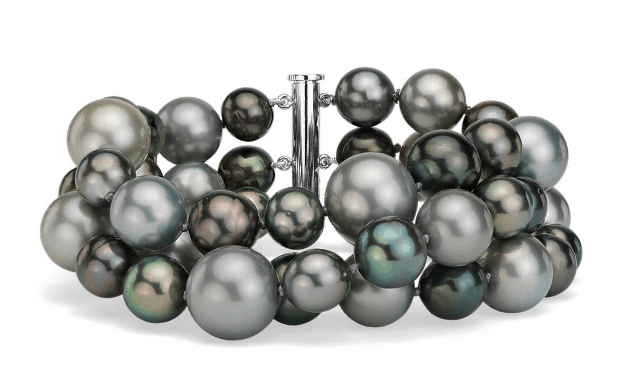
What are cultured pearls?
Are cultured pearls real?
What are the types of cultured saltwater pearls?
What are the types of cultured freshwater pearls?
What is the difference between cultured saltwater and freshwater pearls?
Why you should trust us
Although buying a pearl isn’t as complicated as buying a diamond, there are still several factors that you’ll want to pay attention to. We’ve covered these below with clear explanations and beautiful images.
As always, the vendor you choose for pearl jewelry will have the biggest impact on pricing and value for money. We recommend buying from Blue Nile thanks to their extensive inventory of pearl jewelry, such as earrings, necklaces, and bracelets as well as from James Allen.
Cultured pearls, on the other hand, are not incredibly rare. Cultured pearls are the pearls used to make almost all jewelry on the market today. As reported in this JCK Online report There is a “a “worrying trend” of cultured pearls being inaccurately described online as natural.” When purchasing make sure your jeweler is not selling you “natural color” pearls as natural.
Cultured pearls are pearls that form in saltwater or freshwater after an irritant, such as a tiny bead, is inserted into the oyster shell by a pearl farmer. Layers of nacre form around the irritant to create the pearl—the same as with natural pearls. But because humans are involved in the process, cultured pearls are different from natural ones.
Natural pearls are very rare and fetch high prices at auctions. Finding new natural pearls is exceedingly difficult due to water pollution, sea predators, and premature passing of the oyster. That’s why when buying pearl jewelry, you’ll almost always be looking at cultured pearls. And don’t worry, they can be stunning as well. Look at the winners of the 13th annual International Pearl Design Competition 2022.
Cultured pearls are a beautiful gemstone and are produced in both freshwater and saltwater. Freshwater pearls grow in rivers, lakes, reservoirs, and ponds. Most of them come from China. Saltwater pearls are grown across Australia and Asia. There are three main types of saltwater pearls: South Sea pearls, Tahitian pearls, and Akoya pearls. Saltwater pearls are usually considered more valuable than freshwater pearls.
Cultured pearls can be a variety of shapes, including oval, round, semi-round, pear, baroque, button, drop, and circle. Most pearls are white or black, but you can find pearls in other colors such as pink, green, and silver.
Cultured pearls are real pearls, grown in either freshwater or saltwater. They form when an irritant is inserted into an oyster shell. Once the irritant is there, layers of nacre form over the irritant to create the pearl. The process of culturing pearls is monitored by a pearl farmer—helping to keep the animal alive and allowing for high-quality pearls to form. While culturing pearls is different from the formation of natural pearls, both kinds are real gemstones.
There are two main categories of cultured pearls: saltwater pearls and freshwater pearls. Within the two varieties, there are subtypes based on how and where they’re cultured. Learn all about cultured pearls to determine which gemstone is right for you.
Cultured saltwater pearls are grown in saltwater when a mollusk is implanted in a saltwater oyster shell. Saltwater pearls are grown across countries and islands in Asia and Australia. There are three types of saltwater pearls: Tahitian pearls, South Sea pearls, and Akoya pearls. These pearls range in size from 2mm to 15mm diameter. They’re most often round and white, but can be black or pastel colors.
In general, saltwater pearls are more expensive than freshwater pearls because they take longer to cultivate. A saltwater mollusk only produces a single pearl at a time, whereas freshwater oysters can grow up to 30 pearls at once.
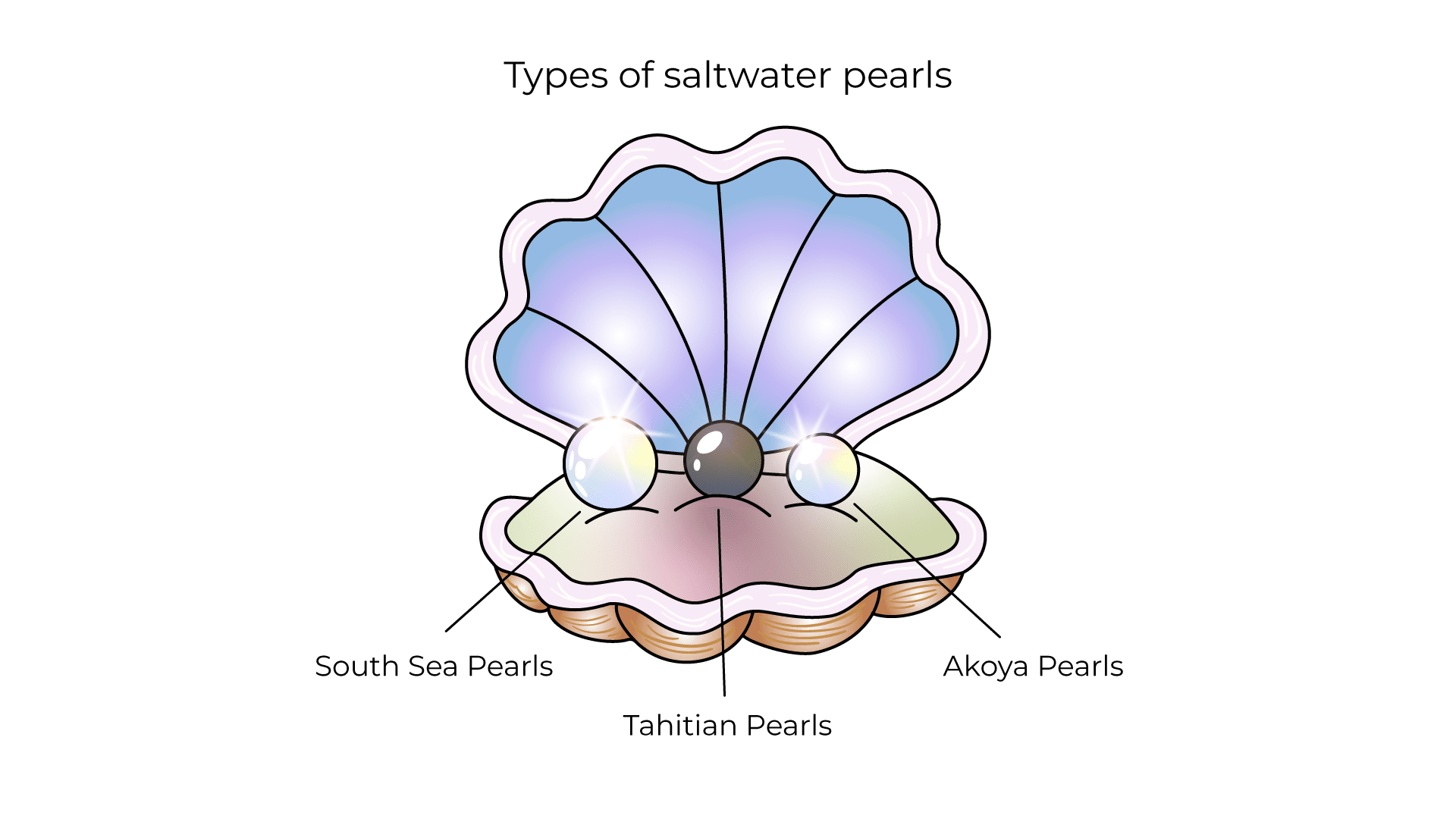
Saltwater pearls make for beautiful jewelry—particularly earrings, necklaces, and bracelets. Because pearls are less durable than diamonds and colored gemstones, pearl engagement rings are rare.
Review the types of cultured pearls to see what style you prefer. Pay attention to the luster and color of the pearl.
Examples of cultured saltwater pearl jewelry:
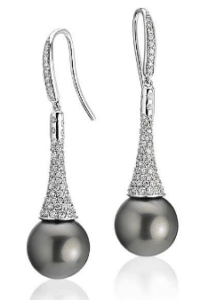
Cultured Tahitian pearls are saltwater pearls grown in the French Polynesian islands. These pearls grow inside the Pinctada margaritifera cumingii oyster. They’re naturally black or gray, although many feature a secondary hue like blue, green, or purple.
The size of Tahitian pearls ranges from 8mm to 18mm. They’re most often round but can be baroque or circular as well.
Tahitian pearls provide lustrous, colorful jewelry options. The deep tone offers character to necklaces, earrings, and bracelets alike. Choose the tint and shape that matches your style and personality.
Examples of cultured Tahitian pearl jewelry:
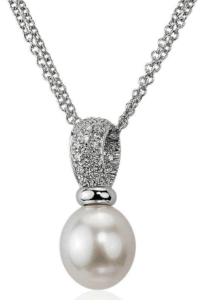
Cultured South Sea Pearls come from the Pinctada maxima oyster and are grown in Indonesia, the Philippines, Australia, and Myanmar. South Sea pearls are usually round and larger than other cultured pearls, with the size ranging from 8mm to 20mm. These high-quality pearls are often white or golden with a high amount of luster. South Sea pearls are very desirable and often the most expensive of the cultured pearl varieties.
Examples of cultured South Sea pearl jewelry:
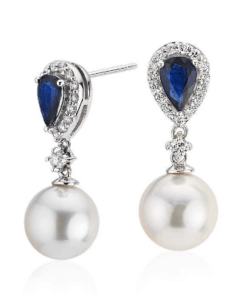
Cultured Akoya pearls are the most abundant saltwater pearl and come primarily from Japan but also from China, Thailand, Vietnam, and Australia. They range in size from 3mm to 11mm, with most being around 7mm. You can find Akoya pearls in white, gray, green, pink, and blue (although rare). Most Akoya pearls are round. Akoya pearls are known for their bright luster and elegance.
Examples of cultured Akoya pearl jewelry:
Cultured freshwater pearls grow in lakes, rivers, and ponds—mostly in China. Freshwater pearls are often white but come in a variety of pastel colors including pink and gold. The most common freshwater pearl shapes are round, oval, and teardrop.
Freshwater pearls are usually less shiny than saltwater pearls because their nacre is thicker. In general, freshwater pearls are also less expensive than saltwater pearls because they’re cultured for a shorter time. Freshwater pearls still offer plenty of luster and beauty. In fact, many people have a hard time differentiating between freshwater and saltwater pearls.
Examples of cultured freshwater pearl jewelry:
Freshwater pearls grow in lakes, ponds, and rivers, and are one type of cultured pearl. Cultured pearls refer to all pearls that involve human intervention, including freshwater and saltwater pearls.
The majority of freshwater pearls are grown in China, and may even be called Chinese freshwater pearls. Freshwater pearls include a variety of pastel colors but are usually white. They come in all shapes and sizes, but round, teardrop, and oval are the most common.
You can’t go wrong with any type of pearls. Just do some research, look at all types and go with what pleases your eye.




Before you buy a diamond, get personal buying advice from industry veterans. We'll help you get the best diamond for the money.
DISCLAIMER: We don't use your email for marketing. Period.
A diamonds’ price is determined primarily by the 4 Cs of the diamond. On the wholesale level, diamond prices are first based on a diamond shape and
Buying an engagement ring is often one of the first major purchases in a person's life. The process can be fraught with tension as there are so m
A wide range of 1 carat diamonds exist both in online markets and local diamond jewelry stores. Not only are there significant differences in beauty
Please enter your email address to receive your 25% off coupon code:
Here is your coupon code: GFDSF3GF